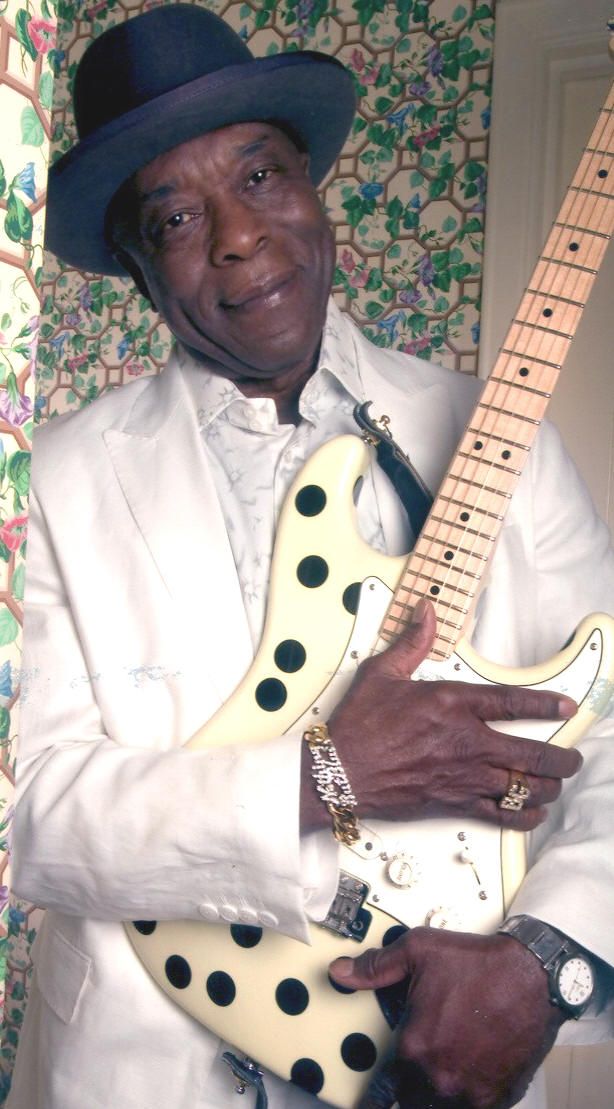|
Biography
He's Chicago's blues king today, ruling his
domain just as his idol and mentor Muddy Waters did before him. Yet there
was a time, and not all that long ago either, when Buddy Guy couldn't even
negotiate a decent record deal. Times sure have changed for the better --
Guy's first three albums for Silvertone in the '90s all earned Grammys. Eric
Clapton unabashedly calls Buddy Guy his favorite blues axeman, and so do a
great many adoring fans worldwide.
High-energy guitar histrionics and boundless on-stage energy have always
been Guy trademarks, along with a tortured vocal style that's nearly as
distinctive as his incendiary rapid-fire fretwork. He's come a long way from
his beginnings on the 1950s Baton Rouge blues scene -- at his first gigs
with bandleader "Big Poppa" John Tilley, the young guitarist had to chug a
stomach-jolting concoction of Dr. Tichenor's antiseptic and wine to ward off
an advanced case of stage fright. But by the time he joined harpist Raful
Neal's band, Guy had conquered his nervousness.
Guy journeyed to Chicago in 1957, ready to take the town by storm. But times
were tough initially, until he turned up the juice as a showman (much as
another of his early idols, Guitar Slim, had back home). It didn't take long
after that for the new kid in town to establish himself. He hung with the
city's blues elite: Freddy King, Muddy Waters, Otis Rush, and Magic Sam, who
introduced Buddy Guy to Cobra Records boss Eli Toscano. Two searing 1958
singles for Cobra's Artistic subsidiary were the result: "This Is the End"
and "Try to Quit You Baby" exhibited more than a trace of B.B. King
influence, while "You Sure Can't Do" was an unabashed homage to Guitar Slim.
Willie Dixon produced the sides.
When Cobra folded, Guy wisely followed Rush over to Chess. With the issue of
his first Chess single in 1960, Guy was no longer aurally indebted to
anybody. "First Time I Met the Blues" and its follow-up, "Broken Hearted
Blues," were fiery, tortured slow blues brilliantly showcasing Guy's
whammy-bar-enriched guitar and shrieking, hellhound-on-his-trail vocals.
Although he's often complained that Leonard Chess wouldn't allow him to turn
up his guitar loud enough, the claim doesn't wash: Guy's 1960-1967 Chess
catalog remains his most satisfying body of work. A shuffling "Let Me Love
You Baby," the impassioned downbeat items "Ten Years Ago," "Stone Crazy,"
"My Time After Awhile," and "Leave My Girl Alone," and a bouncy "No Lie"
rate with the hottest blues waxings of the '60s. While at Chess, Guy worked
long and hard as a session guitarist, getting his licks in on sides by
Waters, Howlin' Wolf, Little Walter, Sonny Boy Williamson, and Koko Taylor
(on her hit "Wang Dang Doodle").
Upon leaving Chess in 1967, Guy went to Vanguard. His first LP for the firm,
A Man and the Blues, followed in the same immaculate vein as his Chess work
and contained the rocking "Mary Had a Little Lamb," but This Is Buddy Guy
and Hold That Plane! proved somewhat less consistent. Guy and harpist Junior
Wells had long been friends and played around Chicago together (Guy supplied
the guitar work on Wells' seminal 1965 Delmark set Hoodoo Man Blues,
initially billed as "Friendly Chap" because of his Chess contract); they
recorded together for Blue Thumb in 1969 as Buddy and the Juniors (pianist
Junior Mance being the other Junior) and Atlantic in 1970 (sessions
co-produced by Eric Clapton and Tom Dowd), and 1972 for the solid album
Buddy Guy & Junior Wells Play the Blues. Buddy and Junior toured together
throughout the '70s, their playful repartee immortalized on Drinkin' TNT 'n'
Smokin' Dynamite, a live set cut at the 1974 Montreux Jazz Festival.
Guy's reputation among rock guitar gods such as Eric Clapton, Jimi Hendrix,
and Stevie Ray Vaughan was unsurpassed, but prior to his Grammy-winning 1991
Silvertone disc Damn Right, I've Got the Blues, he amazingly hadn't issued a
domestic album in a decade. That's when the Buddy Guy bandwagon really
picked up steam -- he began selling out auditoriums and turning up on
network television (David Letterman, Jay Leno, etc.). Feels Like Rain, his
1993 encore, was a huge letdown artistically, unless one enjoys the twisted
concept of having one of the world's top bluesmen duet with country hat act
Travis Tritt and hopelessly overwrought rock singer Paul Rodgers. By
comparison, 1994's Slippin' In, produced by Eddie Kramer, was a major step
back in the right direction, with no hideous duets and a preponderance of
genuine blues excursions. Last Time Around: Live at Legends followed in
1998.
A Buddy Guy concert can sometimes be a frustrating experience. He'll be in
the middle of something downright hair-raising, only to break it off
abruptly in mid-song, or he'll ignore his own massive songbook in order to
offer imitations of Clapton, Vaughan, and Hendrix. But Guy, whose club
remains the most successful blues joint in Chicago (you'll likely find him
sitting at the bar whenever he's in town), is without a doubt the Windy
City's reigning blues artist -- and he rules benevolently. ~ Bill Dahl, All
Music Guide
Return to Top
|
